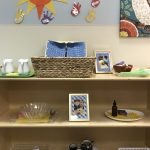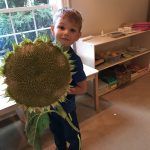Parents often wonder ‘What is Montessori?’ ‘How is a Montessori school different from a traditional school?’. There are many aspects of the Montessori approach and philosophy that make it unique. Over the next several months, we will try to answer questions we hear most often from parents with examples from our teachers and classrooms at Discovery. Through this, we hope you’ll gain a more in depth understanding of this great approach to education and understand why we all love it so much! Let’s start with the classroom itself through this article written by Judi Bertelli.
COMPONENTS OF THE MONTESSORI CLASSROOM
Maria Montessori referred to the classroom as a “prepared environment”. Teachers spend many hours setting up their classroom and continue throughout the school year to evaluate the classroom environment. The Montessori approach includes classrooms that allow for independence, movement, children learning at their own pace, intellectual and social development, self-correction, peer teaching, exploration, self-discipline and freedom. When creating the prepared environment the following six components are considered.
FREEDOM
In keeping with the Montessori approach, the classroom is child-centered vs. teacher-centered. Within the confines of the daily routine children have many opportunities to make choices: when to have snack, what lessons to work with, whether to work alone or with a friend, whether to work on the floor or at a table. Children learn by repetition so they are encouraged to repeat a lesson and they can choose how long they want to work on a lesson before moving on to another.
STRUCTURE AND ORDER
Young children need routine and order in their lives. To  develop mental and intellectual order, their physical environment must be calm, organized and free of chaos. A new lesson includes showing the child how to put the lesson away so that it is ready for the next person and where it belongs on the shelf. Materials are arranged on the shelves in order of difficulty moving from left-to-right. Classroom changes are kept to a minimum and are carefully planned so as not to disrupt the children’s sense of order and need for routine.
develop mental and intellectual order, their physical environment must be calm, organized and free of chaos. A new lesson includes showing the child how to put the lesson away so that it is ready for the next person and where it belongs on the shelf. Materials are arranged on the shelves in order of difficulty moving from left-to-right. Classroom changes are kept to a minimum and are carefully planned so as not to disrupt the children’s sense of order and need for routine.
REALITY AND NATURE

Maria Montessori believed that children should experience nature and not be confined to an indoor classroom, therefore live plants and animals should be included in the classroom. Shells, rocks, leaves, nests, etc. can be on display and available for examination. Many of the materials are made out of wood. The furniture is child-sized and children use small spoons, scoops, pitchers, whisks, mops, brooms, etc. so they can do their work with ease and minimal frustration. The outdoor environment can be an extension of the classroom, therefore allowing exploration and discovery as well as gross motor development.
BEAUTY AND ATMOSPHERE
Children spend many hours in their  classroom, thus it should be a place of beauty and harmony. The didactic materials are attractive, well designed and complete with no broken or missing pieces. The vast variety of lessons are arranged on orderly shelves with each lesson belonging in a specific place. Beautiful art can be displayed on uncluttered walls so as not to be over-stimulating.
classroom, thus it should be a place of beauty and harmony. The didactic materials are attractive, well designed and complete with no broken or missing pieces. The vast variety of lessons are arranged on orderly shelves with each lesson belonging in a specific place. Beautiful art can be displayed on uncluttered walls so as not to be over-stimulating.
SOCIAL DEVELOPMENT
Using controlled body movements and “inside voices”, children are free to move within the classroom and interact with their classmates. Social skills are not innate; they are learned through adult modeling and being part of a community. Good manners, compassion and empathy are modeled and encouraged. The Montessori approach encourages peer teaching which develops naturally due to mixed-age grouping and children learning at their own pace.
Freedom of choice should not be misconstrued as complete freedom – it is freedom within limits. Classroom ground rules are established to allow for a safe classroom. Children learn proper social decorum and learn to respect the adults, their classmates and the materials. While most of the work time is spent in individual work, there are times when the class joins together as a group for stories, transitions, music and other activities. This gives children an opportunity to learn how to behave and attend in a group setting.
INTELLECTUAL AND PHYSICAL DEVELOPMENT
Freedom, structure and order, exposure to nature and beauty in a safe harmonious environment allows for intellectual development. Children are given new lessons and challenges based on their readiness. Age is a guideline but not used to restrict opportunities nor to have age based expectations. The varied curriculum includes lessons in each of the following areas; practical life (sometimes referred to as everyday living), sensorial, language, math, science, geography and culture, art and music. Lessons are presented from simple to complex, from concrete to abstract so children understand concepts and are not just memorizing information.
Fine motor skills are developed primarily in the practical life area – the outdoor playground allows for gross motor skill development.
“The first aim of the prepared environment is, as far as it is possible, to render the growing child independent of the adult”. Maria Montessori – The Secret of Childhood 1996




Comments are closed.